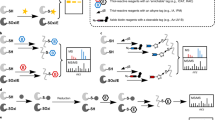Abstract
Because of its versatile chemical properties, the amino acid cysteine plays a variety of vital roles in proteins. It can form structure-stabilizing elements (e.g., disulfide bonds), coordinate metal cofactors and is part of the catalytic center of many enzymes. Recently, a new role has been discovered for cysteine: so-called redox-sensitive proteins use the thiol group of cysteine as a specific sensor for Reactive Oxygen Species (ROS) and Reactive Nitrogen Species (RNS). The oxidation of such a redox-active cysteine, e.g., under conditions of elevated cellular ROS or RNS levels (oxidative or nitrosative stress), often results in a reversible thiol modification. This, in turn, might lead to structural changes and altered protein activity. When the oxidative stress subsides, cellular antioxidant systems, including thioredoxin and glutathione can reduce the redox-active cysteine and restore the original structure and activity of the redox-sensitive protein. This makes oxidative thiol modifications an attractive mechanism for cellular redox sensing and signaling.
To study the target cysteines of oxidative and nitrosative stress and to quantify the extent of the thiol modifications generated under these conditions, we have recently developed a thiol trapping technique using isotope coded affinity tag (ICAT) chemistry (1). With this method, reduced cysteines are selectively labeled with the isotopically light form of ICAT and oxidized cysteines with the isotopically heavy form of ICAT. Thus we could globally quantify the ratio of reduced and oxidized cysteines in cellular proteins based on the modified peptide masses. Here, we present an expansion of this method, which we term NOxICAT, because it uses ICAT chemistry to detect changes in thiol modifications of proteins upon Nitrosative and Oxidative stress. The NOxICAT-method is a highly specific and quantitative method to study the global changes in the thiol redox state of cellular proteins under a variety of physiological and pathological stress conditions.
Access this chapter
Tax calculation will be finalised at checkout
Purchases are for personal use only
Similar content being viewed by others
References
Leichert LI, Gehrke F, Gudiseva HV et al (2008) Quantifying changes in the thiol redox proteome upon oxidative stress in vivo. Proc Natl Acad Sci USA 105:8197–8202
Fridovich I (1977) Oxygen is toxic! Bioscience 27:462–466
Sessions AL, Doughty DM, Welander PV et al (2009) The continuing puzzle of the great oxidation event. Curr Biol 19:R567–R574
Chen Q, Vazquez EJ, Moghaddas S et al (2003) Production of reactive oxygen species by mitochondria: central role of complex III. J Biol Chem 278:36027–36031
Leto TL, Geiszt M (2006) Role of Nox family NADPH oxidases in host defense. Antioxid Redox Signal 8:1549–15461
Fang FC (2004) Antimicrobial reactive oxygen and nitrogen species: concepts and controversies. Nat Rev Microbiol 2:820–832
Lefer DJ, Granger DN (2000) Oxidative stress and cardiac disease. Am J Med 109:315–323
Visconti R, Grieco D (2009) New insights on oxidative stress in cancer. Curr Opin Drug Discov Devel 12:240–245
Allen CL, Bayraktutan U (2009) Oxidative stress and its role in the pathogenesis of ischaemic stroke. Int J Stroke 4:461–470
Antelmann H, Helmann JD (2011) Thiol-based redox switches and gene regulation. Antioxid Redox Signal 14(6):1049–1063
Brandes N, Schmitt S, Jakob U (2009) Thiol-based redox switches in eukaryotic proteins. Antioxid Redox Signal 11:997–1014
Giles NM, Giles GI, Jacob C (2003) Multiple roles of cysteine in biocatalysis. Biochem Biophys Res Commun 300:1–4
Zheng M, Aslund F, Storz G (1998) Activation of the OxyR transcription factor by reversible disulfide bond formation. Science 279:1718–1721
Jakob U, Muse W, Eser M, Bardwell JC (1999) Chaperone activity with a redox switch. Cell 96:341–352
Gygi SP, Rist B, Gerber SA et al (1999) Quantitative analysis of complex protein mixtures using isotope-coded affinity tags. Nat Biotechnol 17:994–999
Dykhuizen RS, Frazer R, Duncan C et al (1996) Antimicrobial effect of acidified nitrite on gut pathogens: importance of dietary nitrate in host defense. Antimicrob Agents Chemother 40:1422–1425
Neidhardt FC, Bloch PL, Smith DF (1974) Culture medium for enterobacteria. J Bacteriol 119:736–747
Sambrook J, Maniatis T, Russel DW (2001) Molecular cloning: a laboratory manual. Cold Spring Harbor Laboratory Press, Cold Spring Harbor
Leichert LI, Jakob U (2004) Protein thiol modifications visualized in vivo. PLoS Biol 2:e333
Forrester MT, Foster MW, Stamler JS (2007) Assessment and application of the biotin switch technique for examining protein S-nitrosylation under conditions of pharmacologically induced oxidative stress. J Biol Chem 282:13977–13983
Brandes N, Rinck A, Leichert LI, Jakob U (2007) Nitrosative stress treatment of E. coli targets distinct set of thiol-containing proteins. Mol Microbiol 66:901–914
Acknowledgments
The authors would like to thank Isabell Fuchs and Dr. Julia Bandow for carefully reading the manuscript and many helpful comments.
This work was supported by a grant from the “NRW-Rückkehrerprogramm” of the German State of North Rhine-Westphalia to L.I.L.
Author information
Authors and Affiliations
Corresponding author
Editor information
Editors and Affiliations
Rights and permissions
Copyright information
© 2012 Springer Science+Business Media, LLC
About this protocol
Cite this protocol
Lindemann, C., Leichert, L.I. (2012). Quantitative Redox Proteomics: The NOxICAT Method. In: Marcus, K. (eds) Quantitative Methods in Proteomics. Methods in Molecular Biology, vol 893. Humana Press, Totowa, NJ. https://doi.org/10.1007/978-1-61779-885-6_24
Download citation
DOI: https://doi.org/10.1007/978-1-61779-885-6_24
Published:
Publisher Name: Humana Press, Totowa, NJ
Print ISBN: 978-1-61779-884-9
Online ISBN: 978-1-61779-885-6
eBook Packages: Springer Protocols




